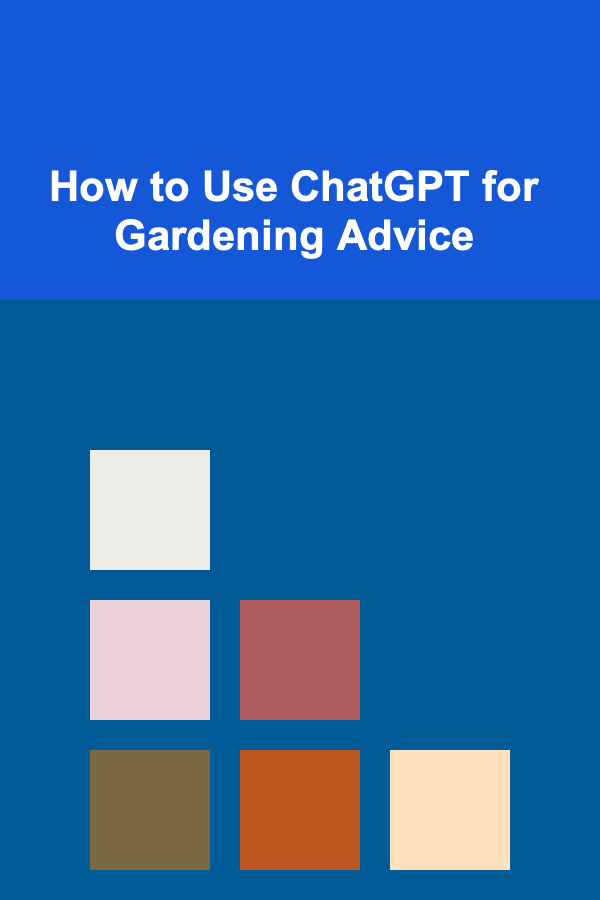
How to Use ChatGPT for Gardening Advice
ebook include PDF & Audio bundle (Micro Guide)
$12.99$7.99
Limited Time Offer! Order within the next:

Gardening is an activity that brings peace, creativity, and a sense of accomplishment. Whether you're cultivating a garden in your backyard or growing plants indoors, the process can be both rewarding and educational. However, gardening comes with its challenges, from choosing the right plants to dealing with pests and maintaining healthy soil. Traditionally, gardeners would rely on books, expert advice, and trial-and-error to perfect their gardening skills. Today, however, technology has provided a new way to access expert guidance: ChatGPT, an advanced AI language model developed by OpenAI.
This article explores how ChatGPT can be utilized as a helpful tool for gardening advice, offering insights into how to optimize its potential, enhance gardening practices, and solve common plant-related problems. Whether you're a beginner or an experienced gardener, this article will show you how ChatGPT can serve as a trusted assistant in your gardening journey.
Understanding ChatGPT: Your Gardening Companion
ChatGPT is a conversational AI tool designed to interact with users, provide information, answer questions, and even engage in deeper discussions on a wide range of topics. Trained on vast amounts of data, ChatGPT can offer solutions based on its understanding of language and factual knowledge up until its last training update.
In the context of gardening, ChatGPT can assist you in numerous ways, whether it's offering plant care tips, helping you troubleshoot issues, recommending plant varieties suited to your environment, or guiding you on the best gardening techniques. The beauty of ChatGPT lies in its ability to provide answers almost instantly, making it a valuable resource for gardeners seeking quick advice or thorough information on specific topics.
Key Ways to Use ChatGPT for Gardening Advice
1. Plant Selection
One of the primary challenges in gardening is choosing the right plants for your climate and space. A gardener's success is often determined by how well plants thrive in their specific environment. ChatGPT can help you make informed decisions when it comes to selecting plants. Here's how:
- Climate-appropriate plants: By sharing your region's climate conditions with ChatGPT, you can get recommendations for plants that will thrive in your area. This is especially useful for those new to gardening or those who have recently moved to a new location.
- Plant compatibility: ChatGPT can advise on which plants grow well together and which ones might compete for resources, helping you create a harmonious and productive garden layout.
- Indoor and outdoor plant choices: Whether you're looking to fill a sunny windowsill with low-maintenance indoor plants or build a vibrant outdoor garden, ChatGPT can help you decide on the best plants for your needs.
For example, you can ask, "What are the best plants for a shaded garden in temperate climates?" or "Which indoor plants thrive in low light?"
2. Gardening Techniques and Best Practices
Gardening is not just about planting; it's about knowing how to care for your plants properly. ChatGPT can help you understand essential gardening techniques, providing information on topics such as:
- Soil health: Learn about the importance of soil pH, organic matter, and nutrients for your plants' health. ChatGPT can offer tips on how to improve soil quality using compost or natural fertilizers.
- Watering strategies: Not all plants have the same watering needs. ChatGPT can help you understand the watering requirements for different species and provide advice on watering techniques, such as drip irrigation or rainwater harvesting.
- Pruning and trimming: Regular pruning is essential for maintaining healthy plants. ChatGPT can guide you on the best times to prune various plants, how to make clean cuts, and which tools to use.
- Pest management: ChatGPT can offer integrated pest management strategies to help you deal with common garden pests. From identifying pests to suggesting natural deterrents, ChatGPT makes it easier to maintain a pest-free garden.
By asking specific questions, such as "How do I prune my tomato plants?" or "When is the best time to water my succulents?", you can receive detailed, step-by-step instructions on how to implement these techniques.
3. Troubleshooting Gardening Issues
Gardening often involves encountering problems, and it's important to know how to identify and resolve these issues early. ChatGPT can help you troubleshoot problems like:
- Diseases and pest infestations: If you notice that your plants are wilting, have discolored leaves, or are being eaten by insects, you can describe the symptoms to ChatGPT. It can then provide suggestions on what might be causing the issue and recommend solutions.
- Nutrient deficiencies: If your plants are not growing well despite regular care, ChatGPT can help identify possible nutrient deficiencies. It can explain the signs of nutrient imbalances, like yellowing leaves (often indicating nitrogen deficiency) or curled leaves (often indicating magnesium deficiency), and recommend treatments.
- Growth problems: ChatGPT can assist in determining why a plant is not thriving as expected. By providing context about your garden's conditions (soil, water, light), you can get advice on how to improve plant health and optimize growing conditions.
For example, you might ask, "My tomato plants are turning yellow. What could be the problem?" or "How do I fix yellowing leaves on my roses?"
4. Gardening Planning and Calendar
Planning is crucial for successful gardening. With ChatGPT, you can develop a personalized gardening calendar based on your location, climate zone, and plant choices. Here are some ways ChatGPT can help:
- Seasonal planting schedules: ChatGPT can provide a seasonal calendar of planting and harvesting times for different plants. This ensures that you plant the right crops at the right time to maximize growth and yield.
- Crop rotation and companion planting: ChatGPT can advise on crop rotation techniques to prevent soil depletion and reduce the risk of pests and diseases. Additionally, it can recommend companion plants that help each other grow.
- Garden layout planning: For those looking to design a garden, ChatGPT can assist with layout suggestions, taking into account the sunlight, space, and growth habits of different plants. It can even help you plan vertical gardens for small spaces or raised beds for better soil control.
By asking questions like, "What are the best vegetables to plant in early spring?" or "How do I create a raised bed garden?" ChatGPT can help you make the most of your gardening space and time.
5. Sustainable Gardening Practices
Sustainability is becoming increasingly important in gardening. ChatGPT can provide advice on how to garden in an eco-friendly way, reducing your carbon footprint and minimizing waste. Some key sustainable practices include:
- Composting: Learn how to turn kitchen scraps, yard waste, and other organic materials into nutrient-rich compost for your garden. ChatGPT can explain the composting process, offer tips on what materials to use, and help troubleshoot any issues.
- Water conservation: ChatGPT can guide you in reducing water usage, suggesting drought-tolerant plants, efficient irrigation systems, and rainwater collection techniques.
- Using organic fertilizers and pesticides: If you prefer organic gardening, ChatGPT can recommend natural alternatives to chemical fertilizers and pesticides, such as neem oil, diatomaceous earth, or companion plants that deter pests.
- Wildlife-friendly gardening: ChatGPT can help you create a garden that supports local wildlife, such as bees, birds, and butterflies. It can recommend plants that attract pollinators and provide shelter for beneficial creatures.
You can ask, "How can I make my garden more sustainable?" or "What are some organic pest control methods for my vegetable garden?"
6. Gardening for Specific Purposes
Whether you're interested in growing a specific type of plant or pursuing a particular gardening project, ChatGPT can provide tailored advice. Here are a few examples:
- Herb gardening: If you want to start an herb garden, ChatGPT can provide guidance on which herbs are easiest to grow, how to care for them, and how to harvest them for cooking or medicinal use.
- Vegetable gardening: If you're looking to grow your own food, ChatGPT can help you plan a vegetable garden, including crop selection, soil preparation, and pest management.
- Flower gardening: ChatGPT can offer tips on growing and caring for various types of flowers, whether for decorative purposes or for attracting pollinators.
- Succulent and cactus gardening: For those interested in low-maintenance plants, ChatGPT can provide expert advice on growing succulents and cacti, which require minimal water and thrive in dry conditions.
For example, you can ask, "How do I grow basil indoors?" or "What are the best vegetables for container gardening?"
How to Ask ChatGPT for Gardening Advice
To make the most of ChatGPT's gardening advice, it's essential to ask specific questions. Instead of asking vague questions like "How do I garden?", narrow down your query to a particular problem or area of interest. Here are some tips for framing your questions:
- Be specific about your location: Gardening advice can vary depending on climate, so mention your location or hardiness zone to receive more accurate recommendations.
- Provide context: If you're experiencing an issue with a plant, describe the symptoms or conditions, such as leaf color, plant size, or pest sightings.
- Use follow-up questions: If the initial response doesn't fully answer your question, feel free to ask for more details or clarification.
By framing questions like "How do I grow tomatoes in a container garden?" or "Why is my rose bush losing its leaves?", you can receive targeted advice that helps solve your gardening challenges.
Conclusion
ChatGPT is a powerful tool for gardeners, offering expert advice, solutions, and personalized recommendations. Whether you're choosing the right plants, troubleshooting problems, or learning new techniques, ChatGPT can help you make informed decisions and improve your gardening practices. Its ability to offer instant, on-demand advice makes it an indispensable companion for gardeners of all skill levels.
By leveraging the potential of ChatGPT, gardeners can cultivate thriving, beautiful gardens while minimizing effort and maximizing results. With its vast knowledge base and user-friendly interface, ChatGPT is not just a tool---it's a gardening partner that empowers you to grow with confidence.

How to Choose Between Short-Term vs. Long-Term Rentals
Read More
How to Create a Scrapbook Photo Album with Personal Touches
Read More
How to Hang Holiday Lights Outside Your Home Without Overcrowding
Read More
How to Make Money Online as a Market Researcher: 10 Actionable Ideas
Read More
How to Amend Your Soil for Optimal Growth
Read More
How to Budget for Home Renovations
Read MoreOther Products

How to Choose Between Short-Term vs. Long-Term Rentals
Read More
How to Create a Scrapbook Photo Album with Personal Touches
Read More
How to Hang Holiday Lights Outside Your Home Without Overcrowding
Read More
How to Make Money Online as a Market Researcher: 10 Actionable Ideas
Read More
How to Amend Your Soil for Optimal Growth
Read More